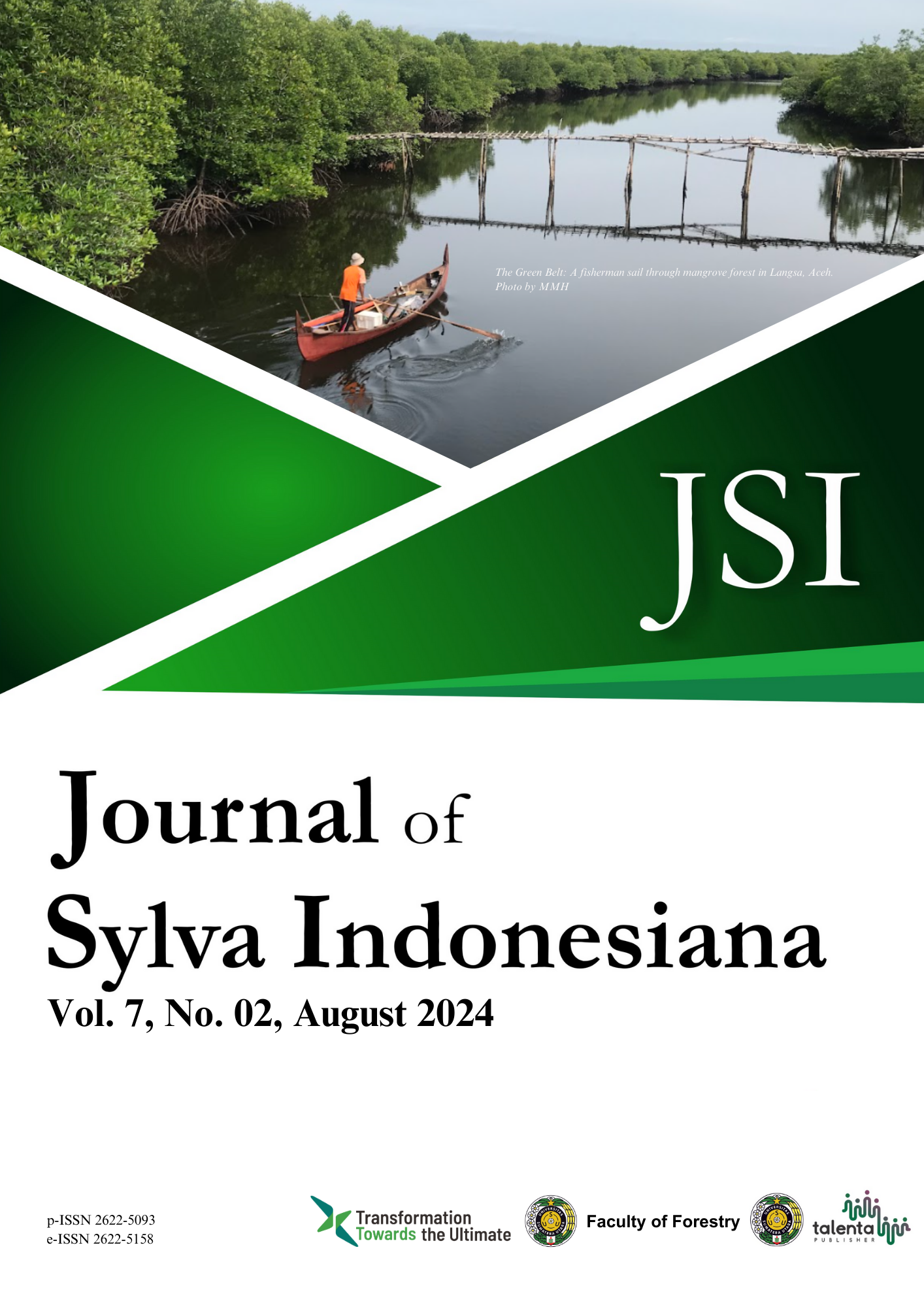Population and Habitat Management Development Strategy in The Tapanuli Orangutan (Pongo tapanuliensis) Conservation Area
DOI:
https://doi.org/10.32734/jsi.v7i02.12703Keywords:
Conservation Area, Development Strategy, Orangutan Habitat, Orangutan Population, Tapanuli orangutan (Pongo tapanuliensis)Abstract
Tropical forests in Indonesia, which are mega biodiversity countries, have a rich diversity of species, including the Tapanuli orangutan (Pongo tapanuliensis). This species is found in the Batangtoru landscape, mostly in the Other Use Areas (OUA) zone, which can pose a potential threat. The importance of meaningful and long-term local stakeholder engagement. It is necessary to strengthen the management capacity among stakeholders. Therefore, a study of the strategy for developing conservation area management is required. This research aimed to analyze the development and management strategy of conservation areas by related institutions to support the Tapanuli orangutan population and habitat conservation. Despite facing various threats to orangutan conservation, stakeholders still have internal strength. The strategy that must be implemented is to use strength to take advantage of long-term opportunities through a diversification strategy
Downloads
References
Keong, C. Y. (2015). Sustainable resource management and ecological conservation of mega-biodiversity: the Southeast Asian Big-3 reality. International Journal of Environmental Science and Development, 6(11), 876.
Kumar, A., & Verma, A. K. (2017). Biodiversity loss and its Ecological impact in India. International Journal on Biological Sciences, 8(2), 156-160.
Nater A, Maja PMG, Anton N, Matthew GN, Marc Manuel, Tariq D, Colin G, Marc P, Tugce BS, Christian R, Adriano RL, Serge AW, James A, Marina DR, Gabriella F, Guillem V, Ferran C, Javier PM, Benoit G, Ernst JV, Kristin SW, Ian S. 2017. Morphometric, Behavioral, and Genomic Evidence for a New Orangutan Species. Current Biology. 27 : 3487–3498.
Pasaribu, S. E., & Harahap, R. E. (2017). Partisipasi Kelompok Pecinta Alam Forester Tapanuli Bagian Selatan Dalam Pelestarian Orangutan Sumatera (Pongo Abelii) di Cagar Alam Dolok Sibual-buali Kabupaten Tapanuli Selatan. Jurnal Administrasi Publik (Public Administration Journal), 7(2), 136-157.
International Union for Conservation of Nature and Natural Resources. 2017. The IUCN Red List of Threatened Species: Pongo tapanuliensis.
Kuswanda, W. (2013). Seleksi sumberdaya habitat orangutan (Pongo abelii Lesson 1827) di Cagar Alam Sipirok, Sumatera Utara. Jurnal Penelitian Hutan dan Konservasi Alam, 10(3), 255-271.
Socio-Ecology, F. Berdasarkan Keputusan Kepala LIPI No. 742/E/2012 (440/AU2/P2MI-LIPI/08/2012) Accredited by the Indonesian Institute of Sciences No. 742/E/2012 (440/AU2/P2MI-LIPI/08/2012).
Kuswanda, W., Harahap, R. H., Alikodra, H. S., & Sibarani, R. (2020). Nest characteristics and populations of Orangutan Tapanulis in the conflict areas, Batangtoru Landscape, North Sumatra, Indonesia. Biodiversitas Journal of Biological Diversity, 21(7).
Reed J, Jos B, Rachel C, Josh V, Terry S. 2019. Engaging multiple pemangku kepentingans to reconcile climate, conservation and development objectives in tropical landscapes. Biological Conservation. 238 : 1-9.
Young, J. C., Jordan, A., Searle, K. R., Butler, A., Chapman, D. S., Simmons, P., & Watt, A. D. (2013). Does stakeholder involvement really benefit biodiversity conservation?. Biological conservation, 158, 359-370.
Ichsan, A. C., Soekmadi, R., Adiwibowo, S., Kusmana, C., & Dramaga, J. L. A. K. I. (2017). Peran pemangku kepentingan dalam pelaksanaan model desa konservasi di Taman Nasional Gunung Rinjani. Jurnal Analisis Kebijakan Kehutanan, 14(1), 47-59.
Waddell, S. (2017). Societal learning and change: How governments, business and civil society are creating solutions to complex multi-stakeholder problems. Routledge.
Ndaumanu, F. (2020). Hak penyandang disabilitas: Antara tanggung jawab dan pelaksanaan oleh pemerintah daerah. Jurnal Ham, 11(1), 131-150.
Yeny, I., Agustarini, R., & Heryati, Y. (2018). Analisis para pihak dalam kerjasama pengembangan hasil hutan bukan kayu di Kabupaten Pasaman Barat. Jurnal Analisis Kebijakan Kehutanan, 15(2), 143-164.
Affandy, S. (2022). Impementasi Analisis SWOT (Strenght, Weakness, Opportunity, Threat) pada Organisasi Dakwah. INTELEKSIA-Jurnal Pengembangan Ilmu Dakwah, 4(1), 179-194.
Wang, J., & Wang, Z. (2020). Strengths, weaknesses, opportunities and threats (SWOT) analysis of China’s prevention and control strategy for the COVID-19 epidemic. International journal of environmental research and public health, 17(7), 2235.
Teoli, D., Sanvictores, T., & An, J. (2019). SWOT analysis.
Weihrich, H. (1982). The TOWS matrix—A tool for situational analysis. Long range planning, 15(2), 54-66.
Nasution, I. M., Bintaro, B. K., Kesumawati, C. S., Zahruddin, M., & Nabila, E. A. (2022). Implementation technology for development of a brand communication in company pt. xyz. Aptisi Transactions on Technopreneurship (ATT), 4(1), 16-24.
Bull, J. W., Jobstvogt, N., Böhnke-Henrichs, A., Mascarenhas, A., Sitas, N., Baulcomb, C., ... & Koss, R. (2016). Strengths, Weaknesses, Opportunities and Threats: A SWOT analysis of the ecosystem services framework. Ecosystem services, 17, 99-111.
Culp III K, Eastwood C, Turner S, Goodman, M, Ricketts KG. 2016. Using a SWOT analysis: Taking a look at your organization.
Gurl E. 2017. SWOT analysis: a theoretical review.
Keban YB, Arifin S, Wahyono R. 2019. SWOT analysis and its implementation strategies in educational management. Journal of Education and Practice. 10(12): 86-92.
Wich SA, Singleton I, Nowak MG, Utami Atmoko SS, Nisam G, Arif SM, Kühl HS. 2016. Land-cover changes predict steep declines for the Sumatran orangutan (Pongo abelii). Science advances. 2(3): e1500789.
Legge K. 2014. Human resource management: a critical analysis. In New perspectives on human resource management (pp. 19-40). Routledge.
Aryanto R, Fontana A, Afiff AZ. 2015. Strategic human resource management, innovation capability and performance: An empirical study in Indonesia software industry. Procedia-Social and Behavioral Sciences. 211: 874-879.
Armstrong M, Taylor S. 2020. Armstrong's handbook of human resource management practice. Kogan Page Publishers.
Kuswanda W, Harahap RH, Alikodra HS, Sibarani R. 2021. Characteristics of the Orangutan Tapanuli habitat in the conflict area of Batang Toru Landscape, North Sumatra, Indonesia. Forest and Society. 5(1): 90-108.
Knox, A., Markx, J., How, E., Azis, A., Hobaiter, C., van Veen, F. J., & Morrogh-Bernard, H. (2019). Gesture use in communication between mothers and offspring in wild orang-utans (Pongo pygmaeus wurmbii) from the Sabangau Peat-Swamp Forest, Borneo. International Journal of Primatology, 40, 393-416.
Vogel ER, Harrison ME, Zulfa A, Bransford TD, Alavi SE, Husson S, Farida, W. R. (2015). Nutritional differences between two orangutan habitats: Implications for population density. PLoS One, 10(10), e0138612.
Ashbury AM, Willems EP, Utami Atmoko SS, Saputra F, van Schaik CP, van Noordwijk MA. 2020. Home range establishment and the mechanisms of philopatry among female Bornean orangutans (Pongo pygmaeus wurmbii) at Tuanan. Behavioral Ecology and Sociobiology. 74: 1-21.
Bantimurung MPKTN, Wakka BAK, Muin N, Purwanti R. 2015. Menuju pengelolaan kolaborasi Taman Nasional Bantimurung Bulusaraung, Provinsi Sulawesi Selatan. Jurnal Penelitian Kehutanan Wallacea. 4(1): 41-50.
Hockings, K. J. (2016). Mitigating human–nonhuman primate conflict. The international encyclopedia of primatology, 1-2.
Mori AS, Lertzman KP, Gustafsson L. 2017. Biodiversity and ecosystem services in forest ecosystems: a research agenda for applied forest ecology. Journal of Applied Ecology. 54(1): 12-27.
Downloads
Published
How to Cite
Issue
Section
License

This work is licensed under a Creative Commons Attribution-ShareAlike 4.0 International License.



















